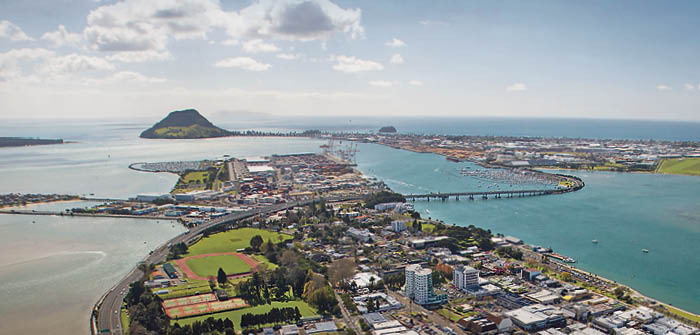The Bay of Plenty economy has enjoyed another strong year and there are plenty of positives for the future. But there are a number of challenges on the horizon for the coming year, according to local business leaders and economic experts.
Despite the Bay’s many strengths, the region is still struggling to deal with the infrastructure and transport problems issues that have come with growth.
“The biggest problem New Zealand has at the moment is a lack of clarity over economic direction.”
– Cameron Bagrie
Businessmen and economists cite potential inflationary pressures, shortages of staff in key areas and a government that has yet to demonstrate a clear vision of how and whether it can deliver on its promise to create a more equal society.
In addition, despite New Zealand’s generally strong economy and trade position, the country and the Bay aren’t immune to global economic pressures. A weak Kiwi dollar may be good for exporters, but it isn’t welcomed by importers and retailers. US president Donald Trump’s trade war mantra and erratic policy statements have created uncertainty and roiled markets worldwide.
And we remain vulnerable to potential problems in China, New Zealand’s biggest potential market for the next few decades.
Red signals not alarming – yet
That said, as Cameron Bagrie, head of Bagrie Economics, noted during a recent presentation to a PMG investor meeting in Tauranga, his “traffic signal” economic indicators suggested that the red lights were not yet at an alarming stage.
The positives included what he saw as a big structural shift across property, led by the downturn in the Auckland residential sector, which had taken some of the heat out of the market. That meant New Zealand was entering the late stages of the current growth cycle in better shape than in the major downturns of 1996-97 or 2006-07.
The major problem, said Bagrie, was that while such sectors as dairy had made a major contribution to growth over the past 20-30 years, that was unlikely to continue at the same level. New Zealand still had to find new sources to replace that growth in the coming years. (see table on page 5)
“The biggest problem New Zealand has at the moment is a lack of clarity over economic direction.”
Bagrie said he believed in the spirit of what the government was trying to do in social terms, but that it needed to work on turbo-charging ways to fill the economic gap emerging as traditional sources of economic growth slowed down.
“The good news is we don’t have a lot of red lights flashing – we’ve got some, but we do not have a smorgasbord,” he said.
“The big one that worries me over the next 12 months is cost-push inflation pressure and whether that seats into general inflation and forces the Reserve Bank to the table. We do have a lot of debt and we need low interest rates to continue.”
Priority One chairman Brett Hewlett noted at the economic development agency’s recent AGM that its vision for Tauranga and the Western Bay of Plenty was for a region that was unique, bold, innovative and future focused – the destination of choice for talented, skilled and creative people and the businesses that need them.
Key areas of focus were fostering an innovation eco-system, business and investment attraction, and talent attraction and retention, he said.
“Tauranga’s also becoming a more expensive place to operate, and our infrastructure is barely coping.” – Stan Gregec
Unprecedented growth
Hewlett cited tangible progress. This has included unprecedented levels of GDP, business and job growth, record-breaking returns for kiwifruit and avocado growers, $350 million of new public and private sector investments planned for Tauranga’s city centre, including the opening in 2019 of a new university campus, and a 10.3 percent increase in trade through Port of Tauranga, the country’s largest sea port.
As reported recently in Bay of Plenty Business News, Tauranga is emerging as New Zealand’s most cost-effective logistics hub for many importers and distributors, according to a new study by Middlebank Consulting Group. The supply-chain agency’s analysis found Tauranga offered around five percent cost savings over Auckland as a hub for distribution to most parts of
New Zealand.
Hewlett said there was also a burgeoning high performance sports sub-economy, strong growth in the construction sector across residential and commercial developments, new cafes and restaurants,; and increasing ethnic diversity across the sub-region.
Hewlett said he believed the reason the Western Bay had been so successful in its economic development to date came down to shared purpose and vision and a strong willingness by key stakeholders to collaborate.
“Less tangible, but never the less impactful, is the buzz that exudes from Tauranga and the Western Bay,” he noted in the agency’s annual report.
“We have outsiders curious. They want to know what it is about the Bay that makes it so special and appealing and they want to be part of it.”
Tauranga Chamber of Commerce chief executive Stan Gregec agreed that it had been another terrific year for Tauranga and Western Bay businesses, which had been reflected across the whole of the Bay of Plenty to a large degree.
“Business confidence remains high in our region – which possibly puts us out on a limb compared with some other parts of New Zealand – and we’ve seen solid growth across multiple indicators of economic activity,”
Gregec said there had been a huge amount of investment going into Tauranga.
“We can see that with the fast growth of industrial estates such as Tauriko and with the transformation that’s happening to our built environment, especially in the CBD.”
But Gregec said it was by no means all plain sailing and there were significant challenges. The government’s new industrial relations policies were seen by many as a step backwards, which might further constrain the labour market.
“Tauranga’s also becoming a more expensive place to operate, and our infrastructure is barely coping,” he said.
“We still seem stuck on some pretty key issues – such as what kind of integrated transport strategy we need to plan for the future. Sometimes it feels like there are simply too many cogs in the system, and not always going in the same direction.”
Doug Leeder, chairman of the Bay of Plenty Regional Council, acknowledged there were still some challenges in terms of the transport issues in Tauranga.
Housing sales were also slowing down, but business and commercial activity was still cranking along, and the economy – especially in the Western Bay – still had plenty of intensity to it, he said. The new Regional Growth Fund’s taking a position on projects in the Eastern Bay was also a positive development.
“Mostly I think there isn’t much despondency around here,” said Leeder.
“Outsiders… want to know what it is about the Bay that makes it so special and appealing and they want to be part of it.” – Brett Hewlett
Support for growth pathway in Rotorua
Acting chief executive Bryce Heard said the Rotorua Chamber of Commerce was excited about the Rotorua economy and was working with business and the council to encourage and facilitate the growth which was being experienced.
“The outcome of a growing economy is a lift in the wellbeing and standard of living for the people in our rohe,” he said.
“In spite of publicity given to some of the naysayers, our members have expressed strong support for the growth pathway. Business confidence is Rotorua is at a high level compared with historical levels, but it needs to rise even higher to maintain and improve the area’s infrastructure. With prudent investment this can and will occur.”
Heard said the new government had announced investment into core infrastructure that would have a positive effect on the Rotorua economy in the medium term.
“We are fortunate to have a powerful and supportive Iwi legacy in this city, who also think and act positively in this space.
“We believe that all of this can be achieved with leading edge environmental parameters, and with the cooperation and leadership of responsible business and Maori interests.”
Hewlett acknowledged the pace of growth in the region was causing some stress and anxiety. The population of Tauranga today is 131,500 people and including the wider Western Bay is now 180,500. More than 50,000 people have been added in the last 20 years and a further 50,000 are expected to arrive in just over a decade.
“When looking across the broad spectrum of our community, the changes we are experiencing may be exciting for many, challenging for some, and just annoying for most,” he states in the Priority One annual report.
“We have a number of significant challenges ahead. Issues around investment in infrastructure, particularly transport; housing affordability; the delivery of healthcare and social services; the affordability of civic amenities such as a museum, new library, performing arts centre and city centre stadium; improved cycle ways and safe and reliable public transport; to name just a few.”
Priority One chief executive Nigel Tutt, commenting in the annual report, noted that looking ahead the outlook for the economy remained strong with our key industries all in good shape.
“While this is excellent as it provides continued job growth, we must be aware that our ability to provide infrastructure to accommodate this growth is stretched,” he said.
“Our focus for the next year will be around helping influence and enable infrastructure investment, particularly gaining the support of the business community, and working to ensure Tauranga and the Western Bay continue to be seen as attractive destinations for talent.”




